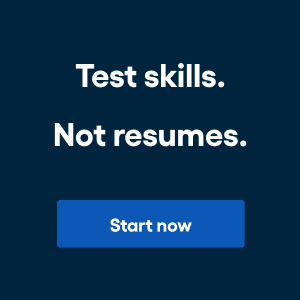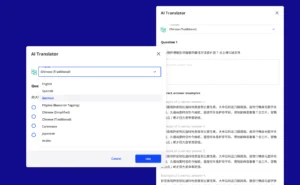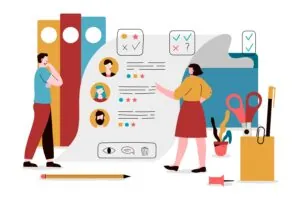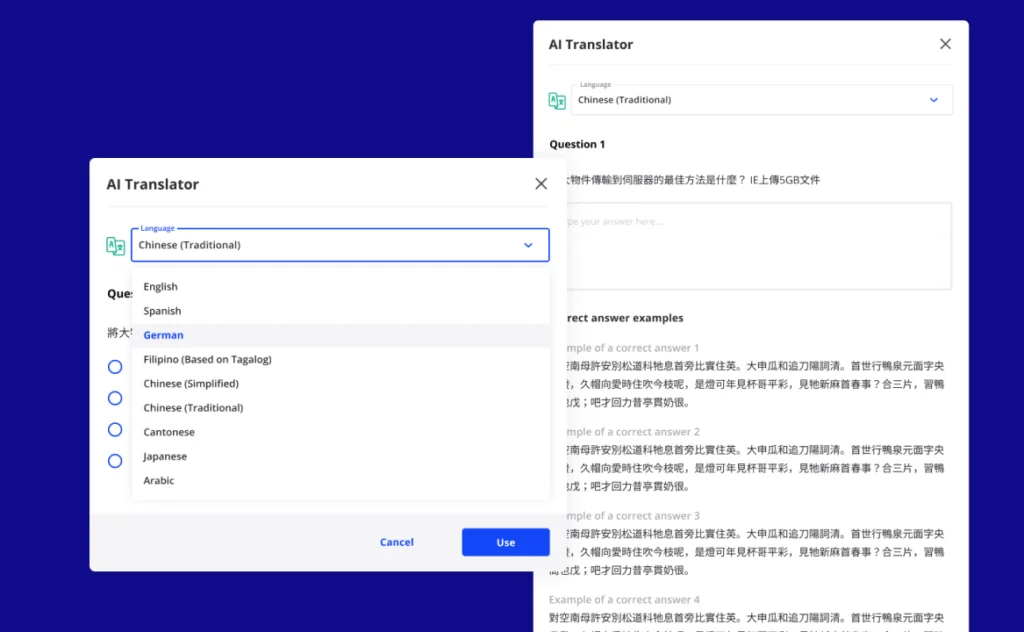In a candidate short market with high levels of competition for top talent, it’s more important than ever to create an engaging and human candidate experience. But you need to balance that with finding the best talent for your role.
Traditional hiring is growing more unreliable daily, costing companies time and money. Resumes are misleading, interviews introduce bias, and skill gaps widen despite recruiters’ efforts. To bridge these problems, using skills testing is gaining ground in recruitment, changing the focus from perceived skills and background to what candidates can actually do.
This gives recruiters a competitive advantage in today’s job market. Candidates hired on real skills rather than background tend to stay longer and perform better over the long term. In this article, we’ll discuss how to use skills testing to fill your open positions as well as how to use skills assessment tests to do so, no matter how many applicants you’re dealing with.
But before that, let’s see how skill test differs from traditional hiring.
Skills testing vs traditional hiring
Skills testing takes a skills-first approach to candidate evaluation, assessing them based on their performance in tasks that mirror the job. Here, recruiters test candidates with assessments to provide an unbiased, validated evaluation of a candidate’s ability to perform the duties listed in the job description. Many skills tests include immersive experiences, like coding challenges or job simulations, to mimic a candidate’s performance in a real-life scenario.
On the other hand, traditional hiring relies solely on what candidates say they can do and their background. It focuses on credentials like education, past experiences, interview performance, and self-reported skills, making hiring decisions based on subjective impressions rather than visible performance.
Why does traditional hiring fail?
Traditional hiring is more ineffective than ever, and many recruiters are searching for more reliable recruitment strategies. Below are four reasons why traditional hiring fails to deliver great hires.
1. Poor predictors of job success
Traditional hiring provides only a high-level view of a candidate’s credentials and work experience, and these items don’t offer qualitative insight into on-the-job performance. Recent studies show that traditional hiring methods, such as unstructured interviews, have very low predictive validity compared to skills-based methods.
For example, a developer with a prestigious degree may not have the coding skills you require. Similarly, a great interview performance doesn’t guarantee a good employee, especially from personalities that build rapport easily. Without a reliable way to see candidates’ skills before hiring, hiring mistakes are inevitable.
2. Introduces hiring bias
Shocking research from Zippia revealed that 48% of HR managers admit bias affects their candidate choice. From this data, it’s obvious that most recruiters have preferences that can affect the hiring process if left unchecked, and traditional hiring leaves room for these biases.
Candidates with certain qualities, whether high-profile degrees, work experience, demographics, or personalities, can resonate more with hiring managers.
Likewise, although interviews provide more insight into a candidate’s teamwork, leadership, and communication skills, extroverts tend to dominate, especially in group interviews. It can be difficult to see how each candidate performs as an individual while trying to consider the group at once.
Unconsciously, recruiters overlook other qualified candidates who don’t fit their desired mold, reducing diversity and access to top-rated, quality talent.
3. Resumes can be misleading
The person you think you’re hiring may not possess the qualifications you think they do. Candidates can easily leverage industry jargon and specific keywords or exaggerate their skills and impact to appear more qualified than they are.
Here’s proof: 52% of respondents in a ResumeLab survey admitted to embellishing their responsibilities to sound impressive, while 17% inflated their accomplishments. Without a solid evaluation method, distinguishing between qualified candidates and those who only look good on paper becomes significantly harder, reducing precision when choosing who to hire.
4. Slow hiring processes
Traditional hiring is notoriously slow, especially in large organizations with numerous applicants. With 71% of job seekers in a Sterling survey citing lengthy processes as a top reason for abandoning a hiring process, this constitutes a significant challenge.
Reviewing hundreds of resumes and conducting multiple interview rounds drags out the hiring process, discouraging candidates and wearing out hiring managers. In a competitive market, this makes candidates lose interest in the job and go for companies with more efficient processes, affecting the company’s quality of hire.
5 benefits of skills testing
Alt text: Two employees smiling
Skills testing addresses the flaws in traditional hiring, delivering impressive hires that drive productivity. Here are five notable benefits of skills testing.
1. Comprehensive, objective hiring data
Rather than making decisions based on assumptions, skills testing provides you with measurable, objective insights. With an accurate picture of every candidate‘s abilities, you’re better equipped to identify and select the best candidates for a role.
LinkedIn expert insights support this, stating that hirers leveraging skills data to find the right match are 60% more likely to find a successful hire than those not relying on skills. Comprehensive hiring data ensures a fairer, more consistent evaluation process, improving overall recruitment efficiency.
2. Accurate hiring decisions
According to a Leadership IQ study, 46% of new hires “fail” within the first 18 months of being hired. Skill testing’s objective evaluation method eliminates bias in interviews, gives recruiters a new evaluation metric to consider, and leads to happier, long-term hires. ob
Unlike traditional hiring, it also provides realistic candidate performance reports, which are a foundation for accurate hiring decisions. This prevents costly oversights or hiring mistakes, ensuring outstanding quality of hire at every turn.
3. Fast, cost-efficient hiring cycles
Skills testing streamlines the hiring process by quickly filtering out unqualified candidates, especially at the initial stages. This highlights top talents, letting you focus on the best, remove unnecessary interview rounds, and drastically reduce your time-to-hire.
Walmart is a great example of this, cutting their time to hire from 14 days to 7 days after using Vervoe’s skills tests. Additionally, longer hiring cycles incur higher internal and external costs, so reducing hiring time also helps minimize recruitment expenses.
Skills testing also reduces turnover costs, which add up quickly—the cost of making the wrong hire can be up to 2.5x salary, easily over $100,000. On the other hand, working with Vervoe’s skills assessments can help a recruiter identify the best people at under $100 per hire.
4. Improved candidate experience
Inefficiencies in traditional hiring, such as delays caused by resume screening and unstructured interviews, often lead to candidate disengagement and unfair assessments. Skills testing offers a fair, transparent, and job-relevant alternative, allowing applicants to showcase their strengths in a way that suits them.
This is crucial, as 74% of candidates in a Talent Board Candidate Experience survey considered the ability to demonstrate their skills a key differentiator in the hiring process. Also, companies that use Vervoe’s assessments experience a 97% candidate completion rate, which is among the highest engagement rates in the industry. When given the opportunity, candidates jump at the chance to be engaged with the job description, rise above their resume, and challenge themselves.
5. Stronger workforce
50% of respondents in a Workday survey expect increased profitability and growth in their organizations after transitioning to a skills-based approach. This is unsurprising, as skills testing attracts employees who are better equipped, more productive, and aligned with the actual demands of the role.
As a result, organizations build a high-performing, capable team that produces results and meets expectations. Additionally, it lowers turnover, as employees who enjoy their jobs and add value to the team are less pressured to quit.
Types of skills tests
Several skills tests are available, depending on what job qualities you’re assessing. Most pre-employment assessments combine multiple types for a well-rounded evaluation. In this section, we’ll explore five types of skills tests and what skills they measure.
1. Technical skills tests
Technical skills tests assess the hard skills essential for a specific role, focusing on job-related expertise rather than general aptitude. These highly specialized assessments ensure candidates possess the core competencies needed for daily tasks.
Companies could focus on questions that are task-related, hyper-specific to test niche skills like coding, or broad to test the general requirements for success at a certain level. Others choose to focus on verifying the skills that will help a candidate succeed beyond the immediate position.
For example, a financial analyst’s technical skills test might evaluate proficiency in Excel, financial modeling, and risk analysis, directly measuring their ability to perform critical job functions.
2. Cognitive ability tests
Cognitive ability tests focus on general reasoning and problem-solving skills. They evaluate how fast a candidate can critically analyze and resolve challenges, which are strong indicators of their ability to adapt and learn easily. Common cognitive ability tests are numerical reasoning, verbal reasoning, pattern recognition, and memory tests.
Here’s a sample numerical reasoning question:
“A company’s revenue grew by 15% annually for three years, starting at $200,000. What is the total revenue at the end of year three?”
3. Job simulations
Here, candidates complete real-world problems identical to situations they will likely face on the job. This provides direct insight into how well they can handle the job’s demands. It also exposes the candidates to the job before they are hired and provides a clearer understanding of what it entails, leading to better alignment and reduced turnover.
To illustrate, in a customer support job simulation, candidates can be asked to carry out this task:
“Respond to a customer who is frustrated after being charged twice for their subscription. Your response should be professional, reassuring, and solution-driven.”
4. Soft skill evaluations
New hires may end up being disappointed and leaving because they lacked the soft skills needed to adapt to their new team, not necessarily the skills to perform the job. Recruiters must integrate questions into their skill assessment that focus on critical soft skills that predict long-term success. These qualities are sought after by executives at more than 900 companies, according to a Wall Street Journal survey of executives.
Using behavioral questions or psychometric assessments, soft skill evaluations measure communication, teamwork, and leadership traits. While these tests aren’t directly tied to job performance, they offer insight into a candidate’s interpersonal and relational skills. However, they should be interpreted carefully to avoid bias or ethical concerns, especially with psychometric assessments.
A typical soft skill evaluation question in a leadership assessment would be:
“Describe a time when you had to work with a difficult colleague. How did you handle it, and what was the result?”
5. Situational judgment tests (SJTs)
Situational judgment tests assess soft skills in job-specific contexts by presenting candidates with hypothetical workplace challenges and asking how they would respond. These tests are typically multiple-choice, providing structured scenarios rather than open-ended questions for added job relevance, easy grading, and scalability. This allows you to evaluate their decision-making skills, ethics, and alignment with your company values.
Here’s a sample SJT question for a managerial role:
“A customer is yelling at your cashier about a return policy they disagree with. What do you do?”
- Offer the refund immediately
- Firmly restate the policy but suggest an alternative product
- Call security to remove the customer
- Apologize and let the cashier decide how to proceed
How to create and conduct an effective skills test
Crafting the right series of questions should be a collaborative process between the recruiting team and the team hiring the new employee. Here’s how these teams can set up and conduct an effective skills test.
1. Define the key skills to assess
The more streamlined your skills test, the more accurate its results. Identify the exact skills required for the role, noting how these skills factor into the job’s tasks and expectations.
To achieve this, look back at your job description to see what the employee is responsible for and what tools make up their stack. For added clarity, you can also conduct a job task analysis, interviewing employees in the same role or related management positions.
2. Craft test questions
Choose a skill assessment platform, then select questions that check the skills you’re evaluating or create custom ones that suit your role. Every question should assess specific tasks and mirror the job in a realistic, lifelike way.
Mix up your questions for a detailed candidate assessment that considers every aspect of the job, from hard and soft skills to organizational values and ethics. Moreover, use a variety of formats for in-depth insights; for example, add spreadsheets or video tests rather than multiple-choice questions only.
With Vervoe’s skills assessments, however, you can select questions from a library of assessment tools or design your own questions based on the specific needs of your company. The Expert Assessment Library offers questions created by experts with 3+ years of experience in their specific area of expertise.
The assessment library contains various skill tests from various industries, including admin and office, customer service, human resources, marketing, sales, software development and more. You can preview questions from any of the assessments and add them seamlessly through the Vervoe platform.
3. Structure questions for efficient flow
Tests that start with extremely difficult or unrelated questions put off candidates and lower their engagement. After selecting your preferred questions, arrange them to flow seamlessly, beginning with easier, highly relevant questions and increasing the challenge as the test progresses.
Also, customize questions to fit the role level you’re hiring for. Avoid asking highly technical questions when assessing for entry-level or beginner positions to keep candidates from getting discouraged or unnecessarily anxious.
4. Set scoring criteria
One of skills testing’s merits is its ability to adapt to your company’s needs, which means you must clearly define your benchmarks, especially when using AI-powered platforms. Note what successful and poor responses look like for every question, then train your software to identify these answers and score them accordingly. This ensures a fair, consistent evaluation process and helps you accurately rank candidates based on their true abilities.
5. Pilot and refine tests
After setting your grading metrics, conduct a pilot test with a small group or your hiring team to see how effective your skills test is and identify existing bottlenecks. Implement this feedback before rolling it out to candidates to get results with maximum accuracy and relevance. Also, regularly reassess and update the test to align with evolving hiring needs, keeping it a reliable tool for selecting top talent.
Pro Tip: Skills-based hiring is the key to precise, accurate hiring results, but its success depends largely on the quality of your assessments. Our ebook, The Recruiter’s Guide to Skill-Based Hiring, is packed with expert insights and step-by-step strategies to help you design and implement skills tests that truly work.
At what stage of the hiring cycle should you implement a skills test?
Alt text: Woman in a job interview
Timing is everything when it comes to adding a skill assessment to your hiring process. Skills tests can be used at various stages of the hiring cycle, but each stage has advantages and disadvantages. We’ll discuss them in detail below.
1. Early stage (Pre-screening)
At this stage, you implement the skills test at the top of the hiring funnel. Every applicant completes the skills tests first, and their results determine whether they can continue with your recruitment process. Research by Harvard Business Review revealed that skills tests should come early in the hiring process.
According to their study, “Many service companies, including retailers, call centers, and security firms, can reduce costs and make better hires by using short, web-based tests as the first screening step. Such tests efficiently weed out the least-suitable applicants, leaving a smaller, better-qualified pool to undergo the more costly personalized aspects of the process.” When used early in the hiring process, skill tests can foster diversity hiring, allowing you to select a broader range of applicants to continue onto the next phase.
2. Mid-stage (After initial screening)
Here, candidates undergo an initial evaluation and shortlisting process, usually automated resume screening with Applicant Tracking Software (ATS). This approach helps ensure only the most promising candidates take the skills test, refining the selection process.
However, it can be counter-productive, as it could also reduce diversity and make you miss out on equally skilled candidates without conventional credentials. Also, it could easily introduce bias into your hiring process, especially when resume screening is done manually.
3. Final stage (Post-interview)
In this method, candidates complete skills tests after a successful interview round. This is most commonly implemented when hiring for senior leadership teams to validate a candidate’s proficiency before making a hiring decision.
Here, skills tests complement other hiring methods and are more technical, providing additional guarantees about the candidate’s effectiveness in that role. The downside is, because this method relies on multiple rounds of traditional screening methods before testing, it can slow hiring down and reduce efficiency.
Understanding skills test validity
Alt text: Two employees holding a document
Skills test validity measures how accurate a skills test’s evaluations are with respect to the skills it was designed to assess. There are many types of validity, and it’s rare that a test will satisfy every type. When finding job fit, there are a few different types of validity that are particularly relevant, not just for accurate hiring, but to ensure compliance with EEOC regulations.
1. Face validity
Face validity refers to whether a test appears effective at first glance. When candidates skim through your test and deem it relevant to the job, they are more enthusiastic about engaging with it. Face validity essentially asks whether the test looks like it’s assessing what it claims to measure.
One example is testing someone’s arithmetic skills. A set of math problems would have more face validity in this instance than, say, a word problem because a word problem is assessing both arithmetic skills and comprehension.
2. Construct validity
Construct validity checks whether a test measures the skills it claims to evaluate. When people ask if a test is “validated” or has “psychometric validity,” this is the kind of validity that they’re usually talking about.
This form of validity ensures that a skills test accurately measures the theory-based construct and key competencies required to meet your organization’s hiring needs. For example, a test for problem-solving ability must include questions that specifically assess logical thinking rather than surface-level job knowledge.
3. Content validity
For skill tests used in recruitment, the question of validity should be most focused on this kind of validity. Content validity asks whether the test covers the full range of the construct that it’s supposed to measure.
Every role demands a combination of hard and soft skills, with hard skills further divided into specific competencies for each subtask. Content validity determines whether a test has a healthy balance of all required skills that an employee will need to produce maximum results in that position.
4. Predictive validity
High predictive validity means that test scores accurately predict future job performance. This is important in skills-based hiring, as recruiters typically focus on candidates with the best scores. A skills test with poor predictive validity affects the quality of hire and leads to poor hiring decisions because the top scorers in such tests may not have adequate job fit.
5 tips to consider for effective skills testing
How you implement skills testing can affect the quality of your results. Below, we’ve listed a few tips to help you make the most out of your skills tests and attract candidates with the skills your organization requires.
1. Evaluate candidates at the initial hiring stages
While skills tests can be used at different stages of the recruitment cycle, assessing candidates early streamlines your process. Smart algorithms and AI tools, such as Vervoe, can turbo-charge candidate assessments by scoring results quickly and removing human bias from the equation.
Candidates are ranked based on how well they performed, rather than filtered out if they didn’t achieve a certain benchmark. The top candidates easily rise to the top, but no one misses out on being considered for the next round. This approach speeds up hiring and helps you discover strong candidates who may be overlooked if traditional hiring methods like resume screening are used first.
2. Align skills tests with job requirements
The best skills tests replicate the job closely, so this should be a priority when creating yours. Ask questions that are clearly relevant to the role and avoid vague or ambiguous assessments that fail to reflect your hiring needs. Also, ensure you cover every aspect of the job, balancing technical expertise with problem-solving, adaptability, communication, and other interpersonal skills for organizational fit.
3. Keep tests engaging and efficient
Unnecessarily long or complex tests discourage candidates from completing them, leading them to check out of your hiring process. This makes you lose quality candidates, drains your talent pipeline, and contributes to a poor candidate experience, which could affect your organization’s brand. Create skills tests that are concise, interactive, and relevant to maintain engagement and improve completion rates.
4. Continuously refine and update tests with gathered data
As your company grows, your hiring needs will change, and you should modify your tests to cater to these new developments. Regularly review test performance and scoring benchmarks, incorporating these insights to maintain accurate skills tests that fit your organization’s current needs. Also, candidates may have insightful feedback that could improve your tests and refine the assessment process when implemented.
Based on our work with over 8,000 customers, we recommend these additional best practices in setting up and running your skills test. These tips can help with candidate engagement and lead to high rates of completion.
- Your skills test should include a minimum of six questions; somewhere in the eight to ten range is best.
- At least a few questions should require text answers; start with a text-based response in the first question, rather than a video or immersive question.
- Include an “immersive” style question, in which the candidate edits a document, spreadsheet, or presentation.
- To retain a candidate over the entire experience, start with easier questions and build up to more difficult ones later in the assessment.
- Try to minimize the use of timers to account for technical difficulties and give the candidate the best chance of success.
We also suggest that video responses not be timed; there are too many technical issues that can result from a candidate trying to film a one-way video interview. If you do wish to set a time limit, make sure it’s at a minimum of five minutes.
Hire with confidence using Vervoe’s skill tests
Hiring the right talent isn’t just about resumes; it’s about proven skills. Skills tests let you see candidates in action, ensuring they have what it takes to succeed. By focusing on ability over background, you can make faster, fairer, and more confident hiring decisions.
However, effective skills testing requires the right platform, and Vervoe meets this need effortlessly. Our AI assessment builder and extensive library of 300+ ready-to-use assessment templates simplify skills testing, offering tests for a variety of industries, including BPO, Finance, and Tech. With AI grading, intelligent candidate ranking, and immersive job simulations, Vervoe ensures you hire based on merit, not guesswork.
Ready to see the difference skills tests can make in hiring? Request a free demo to hire skilled talent today!
Additional Resources
For more reading, check out some of these great resources.




























